Hubble Space Telescope Spies On Odd Galactic Neighbor And Snaps A Lonely Photo
Irregular galaxies, like ESO 174-1, take on odd and unusual shapes, like a toothpick, rings, or little groupings of stars, according to NASA. These often strange-looking galaxies range from dwarf irregular galaxies with 100 million times the Sun's mass, to large ones weighing in at 10 billion solar masses. ESO 174-1 falls into the irregular category, as it "resembles a lonely, hazy cloud against a backdrop of bright stars."
These oddly shaped galaxies are born from galaxy interactions or collisions most often host a mix of older and younger stars. They can also hold significant amounts of gas and dust, necessary ingredients for making new stars.

Astronomers use parsecs to measure enormous distances to other galaxies. The technical definition of a parsec is the distance and which the radius of Earth's orbit subtends and angle of one second of arc, but in practical terms a parsec equates to about 3.26 light-years. So, utilizing this type of measuring unit makes it easier for astronomers to determine vast distances between galaxies via parallax as the Earth orbits the Sun. As an example, the closest star to our Sun, Proxima Centauri, is around 1.3 parsecs away. This equates to "everyday units" of a mind-blowing 25 trillion miles (40 trillion km).
The program that aims to capture all of our neighboring galaxies was created to utilize the 2-3% of Hubble time that is available between observations. NASA says it is "inefficient for Hubble to make back-to-back observations of objects that are in opposite parts of the sky."

